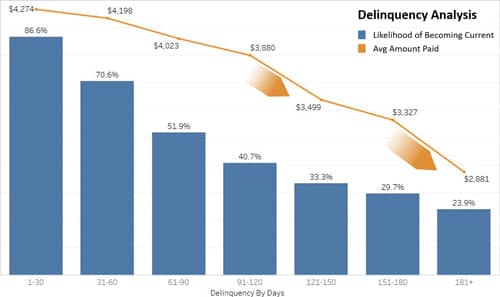Q:When should I dismiss a delinquent patient? When should I write off that patient?
A: Conventional wisdom is that 90 days is the cutoff for collections, but I’m not sure where that came from. It might stem from the time and effort required to manage those active accounts. It’s true that the longer you pursue delinquent accounts, the more accounts you will have to manage. That said, you might be surprised how much you may be leaving on the table by cutting things off so quickly. First of all, terminating a patient in active treatment with insurance vacates any remaining insurance benefit that can help offset some loss. Beyond that, our data shows that although the likelihood of getting delinquent patients to pay declines over time, there is still a good ROI from waiting longer.
The above bar chart buckets patients we manage (excluding the 88% who were never delinquent) by the delinquency aging level they reached, and the likelihood that they became current after that. For example, for all the patients who ever reached 61-90 Days aging, there is a 51.9% likelihood that their account will return to current status after that time range. The orange line shows the average amount those patients paid to the practice. So even after 120 days, there’s still a 33.3% chance they become current, and they pay $3,137 in fees. So where do you cut it off? Looking at the average amount collected can be a good guide. If the commonly accepted maxim is correct that the cost of a wire change is ~$150, then what shakes out is that after 120 days, the ROI on the next wire change drops more than $150, and then after 180 days, it drops again. So we are recommending to our clients that they consider putting patients into inactive maintenance at 120 days, and then terminating and writing off at 180 days. Since it takes no additional team effort with our service, it makes sense to let it ride with a 30% chance of getting that account current, AND the average amount paid is still a break-even to slightly positive ROI for the practice at over $2,900. On top of that, showing patience and empathy with patients and their families can be a powerful contributor to referrals, which is the biggest driver of growth in today’s practice. Conversely, cutting patients off early may freeze future losses, but also creates motivated detractors who are likely to damage your online reputation and ratings—much more costly in the long run.
So sum up all these factors: insurance reimbursement, high likelihood of recouping delinquent accounts, and the overall goodwill of treating these patients. Conclusion? 90 days is the wrong guidepost. Don’t be in a rush to terminate treatment. Time is on your side. OP
About Inside the Numbers: Answers to questions submitted to Inside the Numbers are based on data collected by OrthoFi™, and presented by CEO David Ternan. The data pulls from 200,000+ consults and over 120,000 patient starts in 200 practices, including patient demographics and preferences, risk profile, and payment performance on over $150 million in receivables. Inside the Numbers aims to help you make informed decisions about patient financing and to dispel myths that can hinder growth.
Submit your questions to Inside the Numbers at [email protected].






